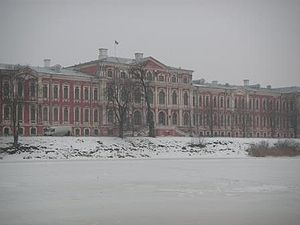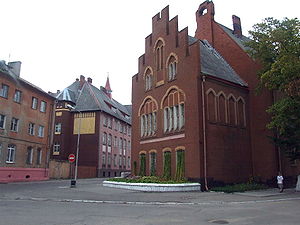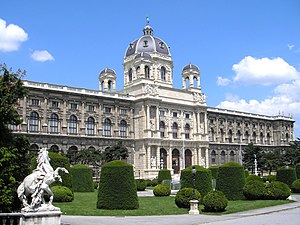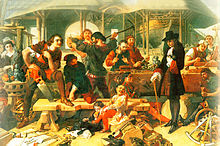Great embassy
The Grand Embassy ( Russian Великое посольство Velikoje possolstwo ) describes a trip by Tsar Peter I to the European West in 1697/98. The Grand Embassy consisted of three ambassadors, Franz Lefort , Fyodor Alexejewitsch Golowin and Prokopy Voznitsyn , 300 other people and 35 volunteers. Their only job was to learn as much as possible from dealing with foreigners. Peter I had chosen the Swiss Lefort as their leader, who had already entered the Russian service under his father Tsar Alexei I.
Peter I was received at all major courts, but no one wanted to fulfill his political concern of supporting Russia in the fight against the Ottoman Empire .
motivation
The aim of the Great Embassy remains controversial in historiography. Peter I wanted to modernize his country comprehensively and make it a major European power. For this he needed a large war and merchant fleet, a modern army, a strong and efficient administration, economy and finance. As early as January 1696, Peter had sent a delegation of young Russian aristocrats to the West to study the techniques of modern economy, warfare and state control. Peter I was particularly interested in the manual and technical side of European education. Peter the Great therefore tried to make this trip even more useful by assigning each of his travel companions a special mission, which mainly consisted of getting acquainted with this or that branch of industry and for the most skilled industrialists of the time to move to Russia move. The tsar's gaze was therefore directed towards the rich states of Western Europe in order to get to know their state structures and society and to catch up with them later. He was also interested in finding military or diplomatic allies against the Ottoman Empire.
Research also suggests that Peter I, with the Grand Embassy, either wanted to secure the existence of the Holy League from 1684 or planned an alliance against Sweden from the start.
travel
On December 6, 1696, the tsar announced his plans to the boyar duma . The boyars reacted with dismay to the Tsar's plans. On March 10, 1697, the entourage set out from Moscow via Novgorod to Riga in Swedish Livonia. The tsar traveled incognito as a non-commissioned officer of the Preobrazhensk regiment in the suite. 14 days later the group arrived in Riga, which had belonged to Sweden since 1629.
The credentials carried by the embassy read:
“Highly wealthy gentlemen, our lofty and powerful ruler, the Tsar, wishes you to receive this letter with respect. And he asks you to not only receive his high-ranking envoys, as soon as they approach your borders, and their entourage with all the honors due to them, but also to grant them audience whenever they request it. "
The then Governor General Erik Dahlberg greeted the Russian diplomats politely, but without a military parade, as he had no official news of the presence of the Tsar. Peter strolled the streets of Riga trying to get news about the fortresses of Sweden. He estimated the Riga garrison at 1,000 men and a small part of the fortifications was not yet completed. The Swedish soldiers did not like the Russian curiosity. When some of these foreigners even wanted to measure the depth of a ditch, they intervened as a guard. After a conversation with the governor Dahlberg, Lefort, head of the Russian legation, had to forbid his subordinates from any further measurement of military targets. Thirteen years later, in 1710, Riga was besieged by Russian troops.
On April 10, 1697, the Tsar reached Mitau , where he stayed for two weeks. Friedrich Kasimir Kettler , Duke of Courland, offered the Russian head of state a particularly friendly welcome, so that the identity of the monarch was no longer hidden from the general public.
After staying in Livonia and at the Courland court, Peter embarked in Libau in April 1697 and went via Pillau to Königsberg in Prussia, where the embassy, headed by Lefort , traveled by land via the Memel . The stay in Königsberg lasted from May to July 1697. In Königsberg Peter I attended an artillery course with the specialist engineer Steitner von Sternfeld. At the end of this course, Peter received a diploma on parchment from his teacher, certifying that "Pyotr Mikhailov" had acquired a deep knowledge of artillery in a surprisingly short time and that he could be considered a clever, reliable and courageous master of this branch . A stay in Berlin followed in August . The negotiations in Prussia, which among other things prepared the future anti-Swedish Northern Alliance between Saxony-Poland , Denmark and Russia in 1699, are the first successes of the legation . Peter waited until the Polish election, which was particularly important for the position of the aristocratic republic within the Holy League, and then traveled to Amsterdam, where he worked from August 1697 to January 1698 at the shipyards of the " East India Company " in Zaandam. As Pyotr Michalow, Peter I received a certificate confirming that he had worked as a ship's carpenter under the supervision of Master Pool for four months and five days , that he had carefully learned all branches of the trade and that he had behaved decently. This was followed by a stay in Nijmegen . The States General took great pains to make the embassy’s stay as pleasant and sumptuous as possible. On September 21, 1697 there was an unofficial meeting between Peter I and the governor of the Netherlands, Wilhelm III. of Orange . Further discussions and business followed.
In January 1698 Peter I drove with a small retinue (25 people) across the English Channel to England. In April 1698 a connection between England and Russia was decided. Since an agreement with the States General could not be reached, the legation concentrated on the acquisition of urgently needed weapons and the recruitment of specialists. In the first few months of the year a large number of experts could be hired for the Black Sea Fleet , after only a few experts could be recruited in Livonia, Courland and Prussia. The number is said to have been around 1100. The legation thus organized a kind of technology push and knowledge transfer from Western Europe to Russia. After all, around 640 of the 1100 or so people were Dutch. In May 1698 the tsar left London and the embassy from the Netherlands without obligation , as peace threatened between the Habsburg Emperor and the Sublime Porte and the most important ally in the fight against the Ottomans and the Crimean Tatars threatened to break away. Within a few weeks, the embassy traveled to Vienna via Hamm , Bielefeld , Halle (Saale) , Leipzig and Dresden .
The visit to Emperor Leopold I in Vienna was the political climax. Of course, although he stubbornly stuck to it, he had nowhere been able to maintain his incognito, for the foreign diplomats accredited in Moscow had informed their governments of the departure of the Grand Embassy to Western Europe and the participation of Peter I. The embassy arrived in Vienna at the beginning of June 1698 and officially moved into Vienna on June 26th after long periods of forced residency in the suburbs. The stay of Peter I turned out to be a foreign policy fiasco. At the end of July the embassy was admitted to the official audience, but the uncompromising attitude of the emperor towards continuing the war with the Sublime Porte could not be changed. While the embassy was still planning their onward journey to Venice and Rome , Peter changed his plans and decided to return to Moscow immediately. The reason was the outbreak of the second Strelizan uprising , which was directed against foreigners in Moscow. In Poland, on August 10, Peter met the Polish King August II , with whom he stayed for three days and had initial talks about joint action against Sweden in the Baltic States. The return journey from Poland to Moscow, where the Tsar arrived completely unexpectedly and bloodily suppressed the Strelizan uprising, took another three weeks.
rating
The Grand Embassy did not achieve its main objective, but collected valuable information about the international situation, which made strengthening the anti-Ottoman coalition impossible due to the expected war over the Spanish Succession . Peter I brought back plans to gain access to the Baltic Sea. On the way back to Russia, Peter the Great had entered into negotiations with August II, which were to form the basis for the Russian-Saxon alliance against Sweden in the Great Northern War .
Aware of his fame as the victor of Azov (1696), Peter was able to appear as an enlightened and popular ruler ("Tsar and carpenter") during the Great Embassy. This image of the tsar has been adopted by foreign diplomats and the press. It was also widely received in the literature of the Enlightenment and Romanticism. The story of this trip inspired the composer Albert Lortzing to write the comic opera Zar und Zimmermann , which premiered in Leipzig in 1837.
literature
- Astrid Blome: The German image of Russia in the early 18th century . In: Research on Eastern European History , Volume 57, Harrasowitz, Wiesbaden 2000, ISBN 978-3-447-04341-0 (also dissertation at the University of Bremen 1999).
- Gennadi E. Kagan: For and against Austria : Austria and the Austrians from the perspective of the Russians in two centuries, Böhlau, Vienna 1998 ISBN 978-3-205-98921-9 .
Web links
Individual evidence
- ↑ The volunteers were not voluntarily members of the legation, but hostages. These noble volunteers were supposed to learn the craft of shipbuilding, but primarily ensure the family's loyalty to the tsar; after Astrid Blome: The German image of Russia in the early 18th century , p. 74.
- ^ Gennadi E. Kagan, p. 144
















